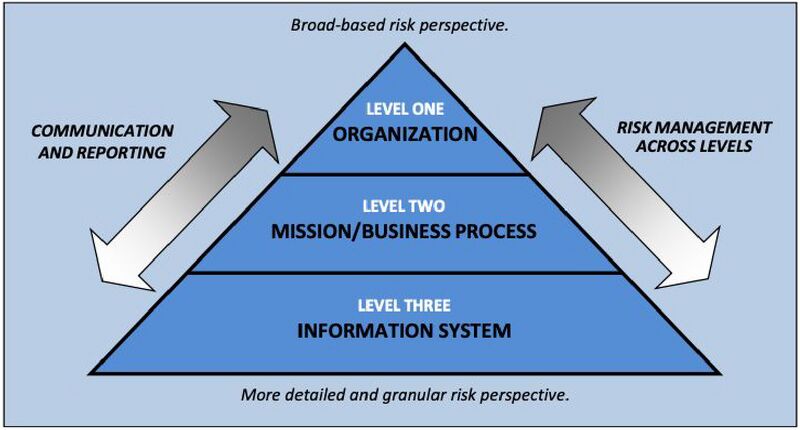Trustworthy Smart Cities through Risk Management: Difference between revisions
(Created page with "{{Chapter | blueprint = Cybersecurity and Privacy | sectors = Cybersecurity and Privacy | authors = Lan Jenson, David Balenson, Adnan Baykal, Gary Dennis, Wayne Dennis, Alex H...") |
No edit summary |
||
| Line 20: | Line 20: | ||
Organizations will need to adopt processes and practices that are appropriate for their specific needs. The NIST Risk Management Framework (RMF) is one tool, of many, that can help organizations supplement and refine existing risk management practices or establish new risk management processes. At the most generic level, the RMF consists of seven iterative steps - an initial preparatory step to ensure readiness to execute the process followed by the six main steps - that can be more strategic or tactical as needed. | Organizations will need to adopt processes and practices that are appropriate for their specific needs. The NIST Risk Management Framework (RMF) is one tool, of many, that can help organizations supplement and refine existing risk management practices or establish new risk management processes. At the most generic level, the RMF consists of seven iterative steps - an initial preparatory step to ensure readiness to execute the process followed by the six main steps - that can be more strategic or tactical as needed. | ||
0. Prepare for risk management at all organizational levels | |||
1. Categorize information and information systems | |||
2. Select and tailor security and privacy controls | |||
3. Implement security and privacy controls | |||
4. Assess (independently) security and privacy controls for proper and intended | |||
implementation, operation, and risk outcomes | |||
5. Authorize system operation | |||
6. Monitor (continuously) to adjust to system and environment changes and to | |||
maintain awareness of organization risk posture | |||
Operationalizing, standardizing and coordinating risk management across an organization is critical for minimizing cybersecurity and privacy risks during the development and operation of Smart City solutions. Cities – and all other participants in the Smart City environment – must determine the appropriate policies and processes to adopt and implement based on their current risk management practices, risk posture, and their risk management strategy. | |||
=What is Cybersecurity and Privacy Risk Management? = | |||
Risk management is a critical practice that not only assists in mitigating potential catastrophic consequences but also enables the success of Smart City systems, projects, and programs by enhancing trust. The risk management process ultimately helps organizations make risk-based business decisions, such as identifying what levels of risk are acceptable to the organization and where investment needs to be made to mitigate risk, namely by reducing vulnerabilities (e.g., implementing security or privacy controls) or limiting consequences (e.g., developing continuity of operations capabilities, purchasing cyber insurance to minimize financial loss). That said, risk management is more substantial than simply implementing more cybersecurity and privacy controls. Organizations can make decisions and investments to reduce vulnerabilities and consequences. The third component of risk – threat – is external to the organization and typically cannot be directly controlled. However, organizations need to understand their sector, industry, or regional threat environment to inform their risk management processes and decisions. | |||
'''NIST’s Approach to Organization-Wide Risk Management''' | |||
[[File:Broad-basedRiskperspective.jpg|800px|Broad-based Risk Perspective]] | |||
Revision as of 19:27, December 19, 2021
| Cybersecurity and Privacy | |
|---|---|

| |
| Sectors | Cybersecurity and Privacy |
| Contact | Lan Jenson |
| Topics | |
- Authors




 [[File:|x100px|link=Alex Huppenthal]]
[[File:|x100px|link=Alex Huppenthal]]











 [[File:|x100px|link=Ed Walker]]
[[File:|x100px|link=Ed Walker]]


{{{summary}}}
Organizations participating in the Smart City environment – whether as municipalities, critical infrastructure operators, product or service providers, or citizens – already consider at least some aspects of risk (e.g., business risk, reputational risk) in the development and deployment of Smart City capabilities and solutions. And one growing area of risk is cybersecurity and privacy risk.
Many of the cybersecurity- and privacy-related vulnerabilities and threats that could affect Smart City environments are similar to those commonly found in the traditional enterprise IT environment. The cyber-physical aspects of Smart Cities as well as the interconnections and interdependencies that are characteristic of Smart City solutions could potentially result in more complex and catastrophic consequences (e.g., disruption of government services to citizens; terrorist event; danger to public health or safety). The recognition of these vulnerabilities, threats, and consequences necessitates the consideration and adoption of risk management processes and practices that can help Smart City organizations make risk-based business decisions, such as identifying what levels of risk are acceptable and where investments need to be made to mitigate risk.
Cybersecurity and privacy risk management does not have to be an undue burden. In fact, there are a variety of tools that can make it easier to integrate risk management; and risk management, in turn, will be an enabler for Smart City solutions and capabilities.
- There is an abundance of existing guidelines, standards, and references to inform and improve risk management processes
- Risk management can be a tool and enabler for Smart City solutions by establishing and increasing trust in government and trust in systems *Leveraging existing relationships (e.g., inter-/intra-governmental, public-private partnerships, new and existing suppliers) to collaborate on risk management objectives can increase effectiveness and efficiency in a limited-resource
environment While the need for cybersecurity and privacy risk management is clear, a successful risk management program will require coordination and commitment from all levels of government and from all Smart City participants.
Organizations will need to adopt processes and practices that are appropriate for their specific needs. The NIST Risk Management Framework (RMF) is one tool, of many, that can help organizations supplement and refine existing risk management practices or establish new risk management processes. At the most generic level, the RMF consists of seven iterative steps - an initial preparatory step to ensure readiness to execute the process followed by the six main steps - that can be more strategic or tactical as needed.
0. Prepare for risk management at all organizational levels 1. Categorize information and information systems 2. Select and tailor security and privacy controls 3. Implement security and privacy controls 4. Assess (independently) security and privacy controls for proper and intended implementation, operation, and risk outcomes 5. Authorize system operation 6. Monitor (continuously) to adjust to system and environment changes and to maintain awareness of organization risk posture
Operationalizing, standardizing and coordinating risk management across an organization is critical for minimizing cybersecurity and privacy risks during the development and operation of Smart City solutions. Cities – and all other participants in the Smart City environment – must determine the appropriate policies and processes to adopt and implement based on their current risk management practices, risk posture, and their risk management strategy.
What is Cybersecurity and Privacy Risk Management?
Risk management is a critical practice that not only assists in mitigating potential catastrophic consequences but also enables the success of Smart City systems, projects, and programs by enhancing trust. The risk management process ultimately helps organizations make risk-based business decisions, such as identifying what levels of risk are acceptable to the organization and where investment needs to be made to mitigate risk, namely by reducing vulnerabilities (e.g., implementing security or privacy controls) or limiting consequences (e.g., developing continuity of operations capabilities, purchasing cyber insurance to minimize financial loss). That said, risk management is more substantial than simply implementing more cybersecurity and privacy controls. Organizations can make decisions and investments to reduce vulnerabilities and consequences. The third component of risk – threat – is external to the organization and typically cannot be directly controlled. However, organizations need to understand their sector, industry, or regional threat environment to inform their risk management processes and decisions.
